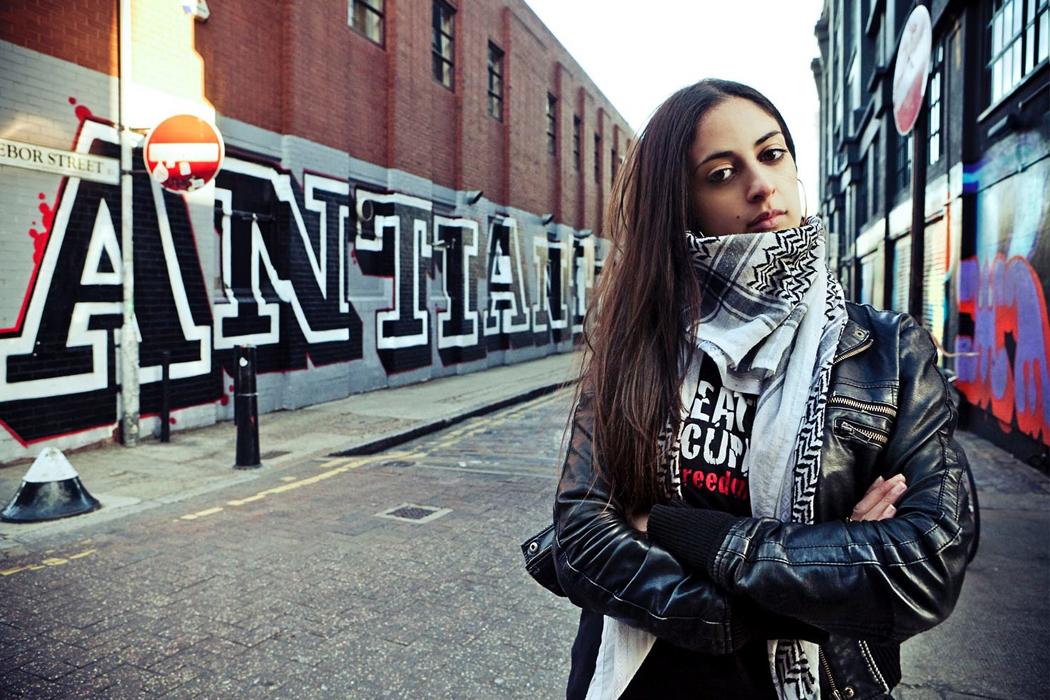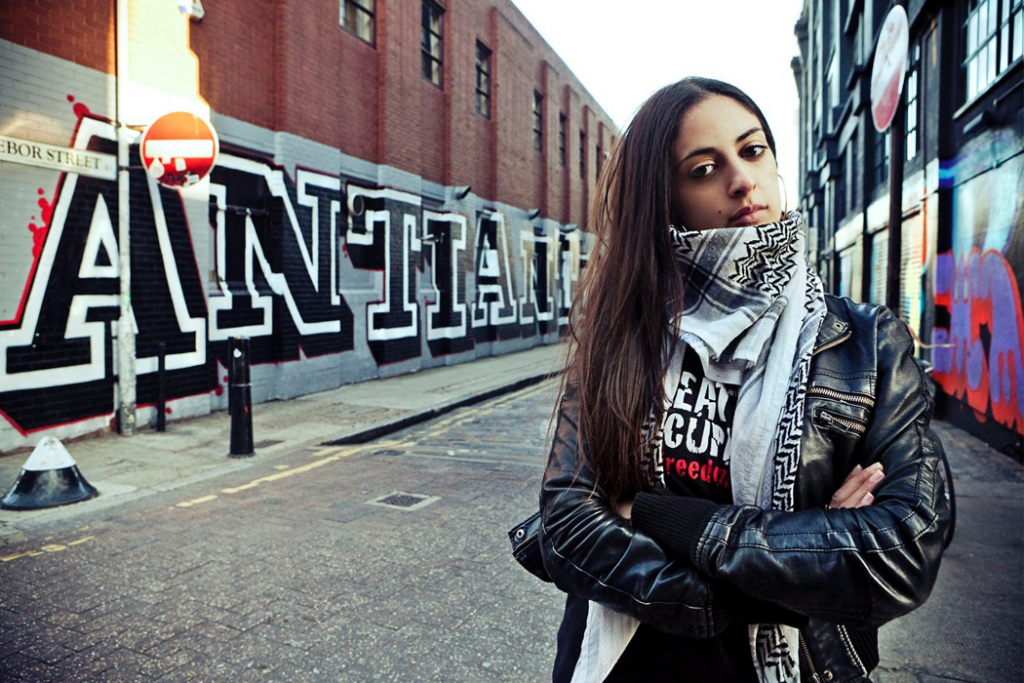
+ Learn the nuances of producing beats, arranging tracks, and creative sampling, drawing on the rich history and influence of hip-hop in Soundfly’s acclaimed online course, The Art of Hip-Hop Production.
The Middle East is quite the hot topic of today’s dinner discussions regardless of whether they’re actually occurring at the dinner table, or on the news, in your Twitter feed, or being injected intravenously into your bloodstream. Everybody wants to share their opinion on the political situation halfway around the world.
Rarely, if ever, do these conversations about the Middle East concern cultural subject matters like art and music. The citizens of this region are, like us, dealing with political catastrophes and devastating lived realities. And, like us, they really need art as an outlet to channel their frustrations. (Apparently, the initial conception of the love song even dates back to early Mesopotamia!)
For many young, talented musicians in the Middle East, the raw, honest, and hard-hitting nature of hip-hop serves as the best format to deliver their stories. We don’t hear about these artists very often here in the United States, but there are ways to find them. A great place to start discovering independent Middle Eastern artists of all genres is the streaming platform Mideast Tunes.
I’m here to introduce you to some of my favorite rappers currently dominating the admittedly small world of Arab hip-hop. Their voices need to be heard.
Before identifying as a musician and a lover of hip-hop music and culture, I am a Palestinian and a Muslim. I’m angry at the way our culture is perceived, treated, and misunderstood these days, especially considering Trump’s misguided executive order on immigration, a.k.a. the “Muslim Ban” a few years back.
It’s crucial for me to share with you the work of these artists, even just to illustrate a small fraction of what they feel and experience in their day-to-day lives. Some spit in English, Arabic, or both, but all share in the unique experience of being Arab and Muslim in today’s world.
If you’re longing to enhance your own skills as a hip-hop beat producer, we just launched our brand new online course on hip-hop production called The Art of Hip-Hop Production. Check it out now and preview a full lesson for free! For now, here’s our list!
The Narcycist a.k.a. Narcy
The Narcycist or simply Narcy (a.k.a. Yassin Alsalman) was the first Arab rapper I ever discovered back in 2010! Narcy’s family is from Basra, Iraq, but he was born in Dubai. Later on, his family moved to Montréal, Canada where he’s now based.
He describes his life as a constant back and forth between the UAE and Montréal — his high school years were spent in Dubai, but he went to university in Montréal.
Narcy is an ambitious artist; he’s also an actor, journalist, and educator, seeking to transmit his experience of being Arab (especially Iraqi) in the West through his work.
As a part-time professor at Concordia College, he turns the mirror around on the genre. Narcy teaches a class called “Hip-Hop: Past, Present, and Future,” enlightening youth on how hip-hop itself, as an art form, goes hand in hand with a culture of resistance.I first heard about Narcy after he released the single above, a collaboration with Shadia Mansour. The track pays aesthetic tribute to ’90s rap while his verses address the collective shared experience of the Arabic diaspora.
He released his first mixtape, Stuck Between Iraq and a Hard Place, in 2006. Since then, he has released three albums, among them Nargisee, one of my personal favorites right now. His most recent collaboration is a track with Yasiin Bey (f.k.a. Mos Def) and the Canadian First Nations rap group A Tribe Called Red, called “R.E.D.”
Omar Offendum
Born in Saudi Arabia and raised in Washington D.C., Omar Offendum is a Syrian rapper, poet, and activist (or “peace pusher” as he calls it). Starting out as part of the N.O.M.A.D.S. duo with Sudanese-American rapper Mr. Tibbz, he then moved to Los Angeles to collaborate with Palestinian-Filipino trio the Philistines.
Offendum raps both in Arabic and English and has said that his music works to convey the complexity of the Arab-American identity. He tours the world not only with his music but also holding lectures and workshops at major universities like Stanford.
In 2010, he released his debut album SyrianamericanA and has continued to release EPs since, collaborating with several well-known Arabic rappers. His track “#Jan25 Egypt” (referencing the Egyptian revolution in 2011) went viral at the time and became a kind of anthem for young Egyptians.
I was lucky enough to interview Offendum back when I was writing a report on the emergence and popularity of Arab hip-hop. We spoke about the impossibility of being both Arab and an artist without also being politically charged. He explained that “until the war in Syria, [he] was barely getting any followers. But quickly, being Syrian was instantly politically relevant… and people were more interested in [him].”
In March 2013, he lectured on hip-hop and peace at the Nobel Peace Prize forum. Check out his speech here:
Shadia Mansour
Shadia Mansour is one of the most powerful and beautiful voices of the Palestinian resistance. She is a British-Palestinian MC, though she became known by performing classical Arab protest music at an early age. Mansour is now dubbed the ‘‘first lady of Arabic hip-hop,” though sadly, she’s probably still one of the only ladies in the game.
Her family hails from Haifa and Nazareth, and she spent most of her summers visiting extended family there. Onstage, she reps the Palestinian people by wearing a traditional Palestinian thawb (see the video above).
She is, no doubt, an outspoken and patriotic Palestinian, rapping almost exclusively in Arabic. She describes her music as “a musical intifada (uprising) against oppression,” whether it be the occupation of Palestine, the repression of women, or the conservative opposition to her music.
The young rapper has collaborated with various well-known hip-hop artists, including Public Enemy, Lowkey, DAM (a Palestinian-based trio), Narcy, and Offendum
Her single with Dead Prez, “Al Kuffiyeh 3Arabeyyeh” (“The Keffiyeh Is Arab”), gained a lot of support among the Arab diaspora. It’s Shadia’s criticism of the commercial use of the keffiyeh scarf as a fashion accessory. Today, the keffiyeh is a symbol of resistance and solidarity for Arab people, and the soundtrack to that perspective is Shadia’s song.
Lowkey
Kareem Denis, better known by his stage name Lowkey, is a British-Iraqi rapper, poet, and political activist. Born and raised in London, he began rapping at the age of 12 and has been considered a prodigy ever since.
His rap career took off in 2003 with a series of mixtapes entitled Key to the Game, the third volume of which later gained critical acclaim from the wider array of UK hip-hop circles.
At the time, Lowkey was part of the hip-hop collective Poisonous Poets. Back in the day, he was in the same circle as Shadia Mansour and collaborated with her and many of the same artists, including Dead Prez. He also worked with Lupe Fiasco and M-1.
He released his first album, Dear Listener, in 2008 and followed that up with Soundtrack to the Struggle in 2011 on his own label, Mesopotamia Music. Lowkey is known to be upfront about his political opinions and, like many outspoken rappers, has been labeled aggressive and hostile.
After a four-year hiatus, Lowkey released a track in July 2016 entitled “Ahmed” with Mai Khalil, which revolves around the refugee crisis and Europe’s response. He also released “Children of the Diaspora” this past September, a track puts voice to the struggle of growing up as an immigrant — Arab or otherwise — in the Western world.
Here’s his mixtape, Key to the Game Vol. 3:
DAM and Tamer Nafar
DAM basically pioneered Arabic hip-hop back in the 1990s. I kind of think of them as the A Tribe Called Quest of the Arab hip-hop scene.
Based in Lod, Israel, DAM was founded by brothers Tamer and Suhell Nafar and their friend Mahmoud Jreri, Arab citizens of Israel. Their experience is a unique one because it echoes the origins of hip-hop in New York. Situated on the outskirts of a large city like Tel Aviv, Lod was similar to The Bronx in the ’80s where hip-hop grew up.
The group raps about poverty, drug culture, and the experience of being second-class citizens in a country that doesn’t want you. They’ve rapped in Hebrew and Arabic with some English tracks here and there. Their stories offer a unique perspective on the Israeli/Palestinian conflict, one that starkly differs from artists like Shadia Mansour. But the group didn’t begin as a politically charged ensemble — if anything, they avoided rapping in Arabic in order to attract a local following within Israel.
In 2008, filmmaker Jackie Salloum released a documentary called Slingshot Hip Hop that traces the history of Palestinian hip-hop beginning with DAM in Lod and continues throughout the country.
In 2012, the group released their first album, Dabke on the Moon: Nudbok Al Amar, but have continuously collaborated with other Arab rappers like Narcy, Shadia Mansour, and Lowkey. (Like I said, it’s a small scene).
The head of the group, Tamer Nafar, has carried their values into his own solo career. Today, he’s known globally after his life was documented in the award-winning film Junction 48 directed by Udi Aloni. As an artist who influenced and inspired all the rappers I’ve covered in this article, Nafar is often credited as the godfather of Palestinian hip-hop. In every sense, he has dedicated his life to the genre, which is not an easy career choice when your homeland is constantly at war.
Even if you can’t understand Arabic, listen to how fluid his flow is in this freestyle. (And keep an eye on the TV screen in the corner for shots of Narcy at :38 and Shadia Mansour at 1:58!)
Meryem Saci
Meryem Saci is an Algerian rapper and singer-songwriter based in Montréal, just like Narcy. Meryem and her mother fled Algeria when she was 13 during the country’s civil war.
I discovered her as a member Nomadic Massive, a soul collective that’s dedicated to providing hip-hop through a unique international lens. With eight very eclectic members, they rap in English, Creole, Spanish, French, and Arabic. Saci herself is able to rap in Arabic, English, and French — quite the ambitious young lady, if I do say so myself.
Her music and image are both accessible from so many cultural points of view, which I find such an engaging aspect of her creative identity. She’s toured internationally in Africa, Europe, the Middle East, South America, and more. Saci is currently working on her own solo work and has recently collaborated with Narcy for his Average Type EP. Also, Narcy, Saci, and Omar Offendum are all members of a multimedia artist collective known as the Medium.
And now, here’s the best music video you’ve seen all day:
Who are your favorites? Share in the comments below!
Continue learning about mixing, beat making, vocal recording, and DIY audio production, with Soundfly’s in-depth online courses, including Faders Up: Modern Mix Techniques, Pop Vocal Production, and The Art of Hip-Hop Production. Subscribe for unlimited access here.




